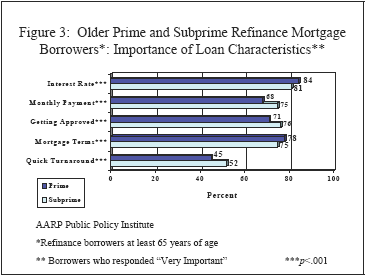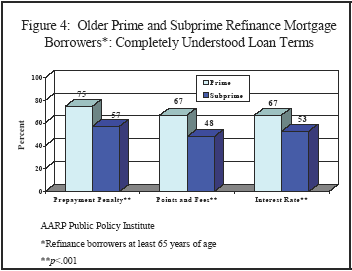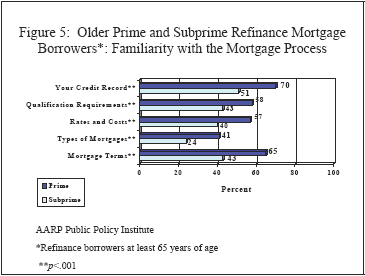Older Subprime Refinance Mortgage Borrowers
Introduction
The subprime mortgage lending industry originated $173 billion in loans in 2001, representing 11 percent of total mortgage originations. Historically, subprime (that is, nonprime or below "A" rated credit) loans have been made to borrowers with blemished—or nonexistent—credit records; typically, borrowers are charged a higher fee to compensate for the greater risk of delinquency and the higher costs of loan servicing and collection.
The majority of subprime loans are refinance loans. According to Home Mortgage Disclosure Act (HMDA) data, the subprime home refinance market ranged from 74 percent of subprime loans in 1996 to 65 percent of subprime loans in 2000 (Figure 1).

While borrowers may refinance to reduce the interest rate of their mortgage, many borrowers liquefy some of their home equity as a source of funds for other expenditures. This can reduce the amount of equity a borrower has in a home, and increase both the monthly payment amount and the loan's length of maturity.
For borrowers with less than perfect credit, or no credit, getting a legitimate home purchase subprime loan may be the first step toward homeownership. For subprime refinance borrowers, however, there are concerns about several aspects of the subprime mortgage lending market.
First, market segmentation in mortgage lending results in differential access to prime credit for many borrowers. Studies have shown that minority and older borrowers are disproportionately represented in the subprime refinance market. Further, two recent studies suggest that between 30 percent and 50 percent of subprime mortgage borrowers could qualify for lower-cost "A" loans, but are paying for more expensive subprime loans instead.
Second, there is growing evidence of predatory lending practices in the subprime mortgage market. One recent study found that more than one-third of the subprime refinance borrowers examined in the study may have had predatory terms included in their loans.
Third, there is concern about the increasing percentage of foreclosures associated with subprime mortgage lending. Studies in both urban and suburban areas have found that the volume of foreclosures associated with subprime loans has increased considerably in recent years.
Methodology
This data digest presents results from a national study of 1,008 subprime and prime refinance mortgage borrowers at least 65 years of age who acquired first lien mortgages between January 1999 and December 2000. Borrowers were selected randomly from public mortgage records and identified as subprime or prime. Using the sample of prime and subprime borrowers, a telephone survey was conducted to obtain information from borrowers about their mortgage experience, including their search behavior, their knowledge about the mortgage process, and their current satisfaction with the mortgage they received.
Findings
Demographic Factors
Older borrowers who were widowed, female, black, and less educated held a significantly greater percentage of subprime loans than older borrowers who were married, male, non-black, and more educated. Widows, for example, accounted for more than one-third (36%) of subprime loans, compared to 28 percent of prime loans. Similarly, blacks accounted for nearly one-third (35%) of subprime loans, compared to only 18 percent of prime loans.
| Prime Loans (%) |
Subprime Loans (%) |
Total Loans (%) |
|
| Marital Status Married Widowed Other |
59 28 13 |
50 36 14 |
57 30 13 |
| Gender Male Femaled |
50 50 |
43 57 |
48 52 |
| Race White Black Other |
73 18 9 |
58 35 7 |
69 23 8 |
| Hispanic Origin Yes No |
3 97 |
7 93 |
4 96 |
| Education <= H. S. Degree > H. S. Degree |
53 47 |
59 41 |
54 46 |
Use of Broker or Lender
Older subprime refinance borrowers were more likely to have used a broker to obtain their loans. More than one-half (53%) of subprime borrowers used a broker, compared to only one-third (34%) of prime borrowers.
Search Behavior
Sixty-one percent of older refinance subprime borrowers reported that the broker or lender, rather than the borrowers, initiated contact before getting the loan, nearly two times more than reported by older prime borrowers (31%) (Figure 2).
Over one-half (54%) of older refinance subprime borrowers reported that they responded to advertisements or sales calls that guaranteed approval, while only 31 percent of prime borrowers did so (Figure 2).

Prime and subprime borrowers differed in their assessment of the importance of several loan features. Low monthly payments, getting approved, and a quick turnaround were the loan characteristics more important to subprime than prime borrowers, while interest rate and mortgage terms were more important to prime than subprime borrowers (Figure 3).

Understanding of Loan Terms and Familiarity with the Mortgage Process
Older subprime refinance borrowers were less likely than older prime refinance borrowers to report completely understanding three key loan terms: prepayment penalties, points and fees, and interest rate (Figure 4).

Older subprime refinance borrowers were less likely to be familiar with the mortgage process than were older prime borrowers. (Figure 5). Subprime borrowers were less likely to be familiar with their credit records, loan qualification requirements, mortgage rates and costs, types of mortgages available, and basic mortgage terms.

Mortgage Refinancing
Older subprime refinance borrowers were more likely to report having refinanced more than once in the past three years, and more likely to consider refinancing within the next 12 months to get cash back or consolidate debts than were older prime borrowers (Figure 6).

Borrower Perception of Mortgage Received
Older subprime refinance borrowers were less likely than older prime borrowers to feel they received: the loan that was best for them, rates and terms that were fair, and accurate and honest information. In addition, subprime borrowers were less likely to want the same loan again or to recommend the broker/lender to a friend (Figure 7).

When asked if their loans were different from what they expected, nearly one-half (47%) of subprime borrowers said yes, compared to only 20 percent of prime borrowers. Of those who responded that the loan was different from expected, 71 percent of subprime borrowers and 50 percent of prime borrowers reported that the loan was worse than expected.
Summary
Older borrowers who were widowed, female, black, and less educated held a significantly greater percentage of subprime loans than older borrowers who were married, male, non-black, and more educated. In addition, they were more likely to have:
- used a broker to obtain their current loan;
- had the lender/broker initiate the contact;
- responded to guaranteed approval advertisements;
- refinanced two or more times within the past three years;
- been dissatisfied with their loans; and
- received a loan different from what they expected.
In addition, these older subprime borrowers were less likely to:
- identify loan characteristics associated with the cost of the loan (interest rate and mortgage terms) as important, while more likely to report quick turnaround, approval, and monthly payment to be important;
- completely understand three loan terms: prepayment penalty, points and fees, and interest rate; and
- be familiar with the mortgage process.
These results suggest that older prime and subprime refinance borrowers had significantly different experiences with refinancing their mortgage. Because home equity is the largest component of the wealth of older households, protecting this equity and expanding access to credit on fair and affordable terms is critical to ensuring the current and future financial security of millions of older Americans.
Footnotes
- Inside Mortgage Finance Publications. Inside B&C Lending (February 11, 2002).
- Inside Mortgage Finance Publications. Inside B&C Lending (February 15, 2002).
- Williams, R., Nesiba, R., et al. "The Changing Face of Inequality in Home Mortgage Lending." Notre Dame Sociology Working Paper 2000-11 (November 2000).
- Canner, G., et al. Recent Developments in Home Equity Lending. Federal Reserve Bulletin (April 1998).
- Brady, P., et al. The Effects of Recent Mortgage Refinancing. Federal Reserve Bulletin (July 2000).
- See, for example, National Training and Information Center. Citigroup: Reinventing Redlining (June 2002).
- Center for Community Change. Risk or Race? Racial Disparities and the Subprime Refinance Market (May 2002).
- Walters, N., and Hermanson, S. (2001). Subprime Mortgage Lending and Older Borrowers, AARP Public Policy Institute. DD57.
- Federal Home Loan Mortgage Corporation. Automated Underwriting Report: Making Mortgage Lending Simpler and Fairer for America's Families (September 1996).
- Carr, J., and Kolluri, L. Predatory Lending: An Overview. Fannie Mae Foundation (2001).
- Stein, K., Libby, M. Stolen Wealth: Inequities in California's Subprime Mortgage Market. California Reinvestment Committee (November 2001).
- See, for example, National Training and Information Center. Preying on Neighborhoods: Subprime Mortgage Lending and Chicagoland Foreclosures (September 1999); Gruenstein, D., and Herbert, C. Analyzing Trends in Subprime Originations and Foreclosures: A Case Study of the Atlanta Metro Area. Abt Associates Inc. (February 2000).
- AARP and Abt Associates Inc. Analyzing Trends in Subprime Originations and Foreclosures in New York: Suffolk, Nassau, and Westchester Counties (forthcoming).
- The national study, conducted by Market Facts for the AARP Public Policy Institute and the Federal Home Loan Mortgage Corporation, included home purchase and refinance mortgage borrowers at least 18 years of age.
- Borrowers were selected randomly from a sample of borrowers generated by DataQuick, a proprietary firm that collects and analyzes mortgage transaction data from county records. Due to the geographic distribution of the sample of borrowers, weighting was necessary. Weights by state are prepared and used to compute estimates for the various characteristics included in the survey to adjust for oversampling or undersampling from a particular state.
- Using the prime and subprime list established by Housing and Urban Development (HUD), as well as industry sources and the Federal Reserve Board, a list of lenders was created representing those institutions that make primarily subprime loans.
* The statistical analysis of the variable "income" does not meet the assumption of homogeneity of variance necessary for the appropriate use of F distribution on which the test of significant differences is based. Therefore, the statistical result from analysis of income differences between the two groups of borrowers was not included.
Written by Neal Walters and Sharon Hermanson, AARP Public Policy Institute
July 2002
©2002 AARP
May be copied only for noncommercial purposes and with attribution; permission required for all other purposes.
Public Policy Institute, AARP, 601 E Street, NW, Washington, DC 20049
